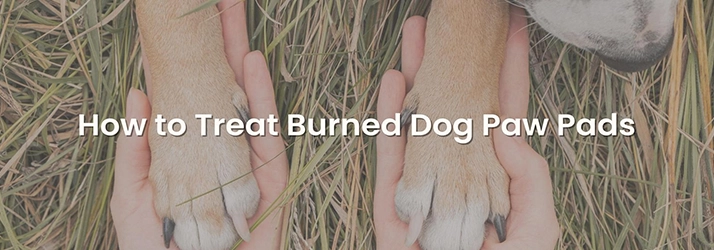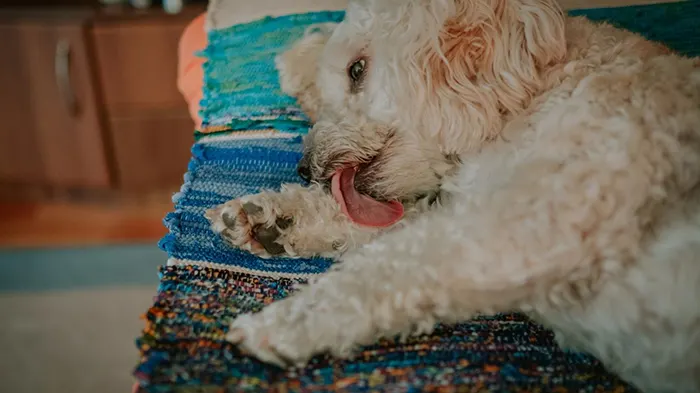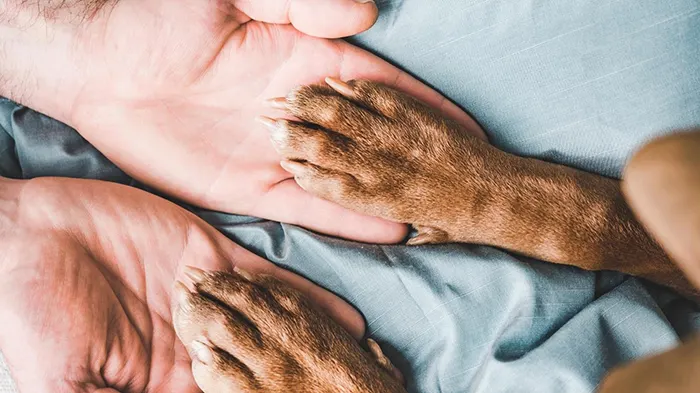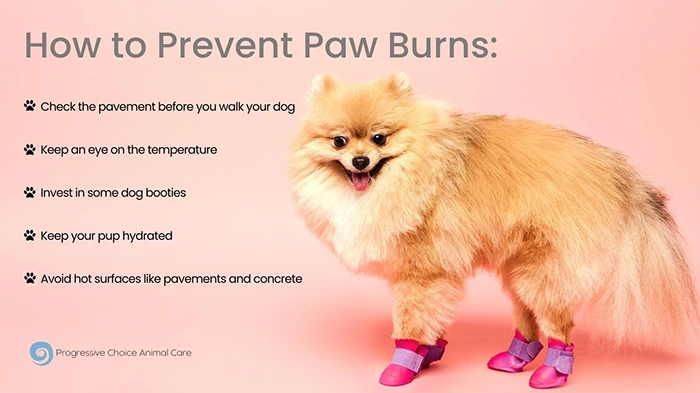How to Treat and Prevent Burnt Paws in Your Dogs in FL?

Summertime often means long walks and fun in the sun with your pet in FL. But it's important to be aware of the dangers that can come with too much exposure to the heat. One such danger is burnt paws, which can occur when a dog walks on hot pavement or sand. Fortunately, there are a few things you can do to help prevent and treat burnt paws.
While at Progressive Choice Animal Care chiropractor in FL can help, we don't treat burnt paws, we feel really passionately about preventing your dog from having to suffer unnecessarily. So we've written this blog to educate and give you a few tips on how to help prevent your dog's paws from, getting burnt this summer.
What are Burnt Paws?
Burnt paws are exactly what they sound like – burns on your dog's paw pads that can be caused by hot pavement, sand, or even walking on grass that has been exposed to the sun for too long. These burns can range from mild to severe and can cause your dog a lot of pain. They are painful and can even lead to infection, so it's important to take steps to prevent them from happening in the first place.
What Causes Burnt Paws?
There are a few different things that can cause burnt paws. The most common is hot pavement or sand. A general rule of thumb to keep in mind to prevent your dog from being burnt is this:
If it's too hot for you to walk on, it's too hot for your pup.
Another common cause is walking on chemically-treated surfaces like pool decks or sidewalks that have been treated with salt. Moreover, hot weather can cause the grass to get very dry and brittle, which can also lead to burnt paws. A less common cause is allergies. Some dogs are allergic to the chemicals in certain grasses, which can cause burns on their paws.
 What are the Symptoms?
What are the Symptoms?
The most common symptom of paw pad burns is, obviously, red and inflamed skin. You may also see blisters or open wounds. Your dog may be limping or walking oddly to avoid putting pressure on the affected area. In addition, in severe cases, you may notice that your dog is licking their paw excessively or refusing to put any weight on it at all.
These are important reactions to take note of in your dog as they can help you to determine the severity of their paw pad burns. Furthermore, if you notice your dog exhibiting any of these symptoms, it's important to take them to the vet as soon as possible.
Can Cold Weather Cause Burnt Paws?
Yes. Believe it or not, cold weather can also cause burns. If your dog walks on salt-treated sidewalks or pavement in the winter, the salt can eat away at their paw pads, causing burns. This is why it's so important to wipe your dog's paws down after a walk in the winter.
How to Prevent Paw Burns?
The best way to treat burnt paws is to prevent them in the first place. Here are a few tips:
Check the pavement before you walk: Use the back of your hand to test the temperature of the pavement. If it's too hot for you, it's too hot for your pup.
Keep an eye on the temperature: In general, you should avoid walking your dog during the hottest parts of the day. If it's too hot outside, try taking them for a walk in the early morning or evening when it's cooler.
Invest in some booties: If you live in an area with particularly hot summers, like here in Florida, you might want to invest in some dog booties. These can help protect your pup's paw pads from the heat.
Keep your dog hydrated: Make sure your dog has plenty of water to drink during walks and play sessions. This will help keep them cool and prevent dehydration.
Avoid hot surfaces: If you can, try to stick to cooler surfaces like grass or dirt. Hot pavement and sand can cause burns quickly, so it's best to avoid them if possible.
How to Treat Burnt Paws?
If your dog does end up with burnt paws, there are a few things you can do to help them heal quickly.
- Cool the area: Run cool (not cold) water over the burned area for a few minutes. This will help reduce swelling and pain.
- Apply a topical cream: There are a few different topical creams that can be used to treat burns. Ask your veterinarian for a recommendation.
- Keep the area clean: Burns can easily become infected, so it's important to keep the area clean. Try to avoid walking your dog in the dirt or mud until the burns have healed.
- Monitor the situation: Burnt paws can be painful, so it's important to keep an eye on your dog. If they seem to be in a lot of pain, or if the burns are severe, call your veterinarian.
Preventing and treating burnt paws is relatively simple if you follow these tips. Just remember to be careful during summer walks and play sessions, and you and your pup will be able to enjoy the warm weather worry-free!
Tips for Keeping Your Dog's Paws Healthy All Year Round
- Regularly check your dog's paw pads for any cuts, cracks, or other injuries.
- Keep your dog's nails trimmed to avoid overgrowth and injury.
- If you live in a cold climate, consider investing in some doggy boots to protect your pup's paws from the cold and salt. Similarly, if you live in an extremely hot climate, like South Florida, dog booties can help protect your dog's paw pads from burns.
- If your dog has any allergies, make sure to keep an eye on their paw pads for any signs of irritation.
- Always be sure to have plenty of water available for your dog during walks and play sessions.
By following these tips, you can help prevent burnt paws and keep your pup's paws healthy all year round!

What Do Extreme Cases of Burnt Paws Look Like?
In extreme cases, dogs can get second-degree burns that require medical attention. If your dog's paw pads are red and swollen, they're in pain, or the skin is blistered or broken, call your veterinarian immediately. These burns can be very painful, so it's important to seek medical help if your dog is in distress.
Never use ice or any other home remedy on burnt paws, as this can further damage the tissue. Burnt paws require medical attention, so always call your veterinarian if you suspect your dog has a burn.
Burnt paws are a common injury in dogs, especially during the summer months. While most burns are minor and can be treated at home, severe burns require medical attention. By taking some simple precautions, you can help prevent burnt paws and keep your pup safe all summer long!
Conclusion
Burnt paws are a common problem for dogs during the summer months. But by taking some simple precautions, you can help prevent them. And if your dog does end up with burnt paws, there are a few things you can do to help them heal quickly. Remember to check the pavement before you walk, keep an eye on the temperature, invest in some booties, and keep your dog hydrated.
If your dog does get burnt paws, be sure to cool the area, apply a topical cream, and keep the area clean. They can be painful, so it's important to monitor your dog closely. If the burns are severe, call your veterinarian immediately. With some simple precautions, you can help prevent burnt paws and keep your pup safe all summer long!
Follow us on social media or read our other blogs to learn how to keep your pets healthy and prevent common injuries.


